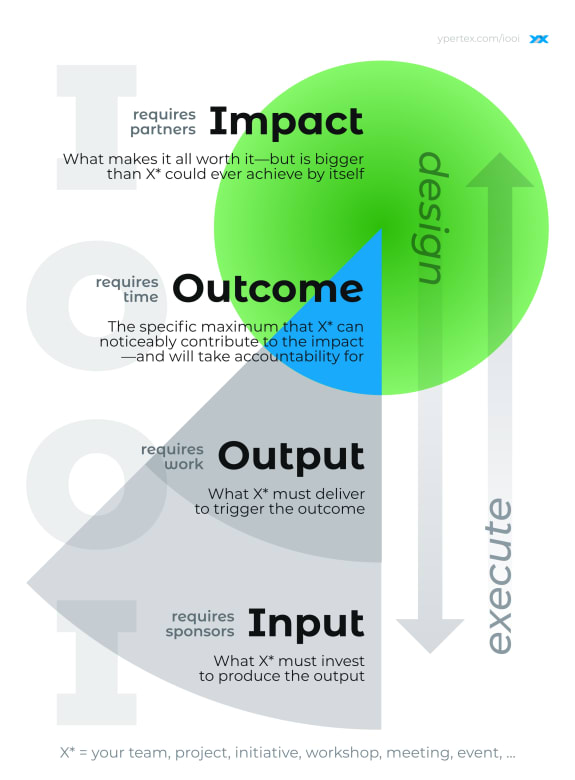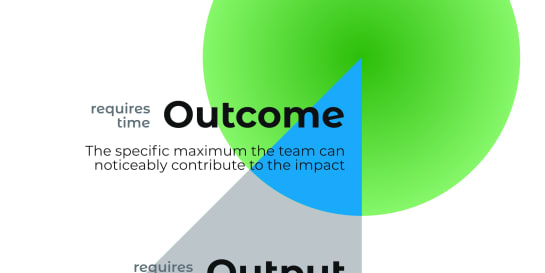IOOI: Put Purpose to Work
Aug 27, 2021 · 6min read · 2 subchapters
We live in times of volatility, uncertainty, complexity, and ambiguity. Let’s take a closer look at a framework called IOOI that can help bring a sense of purpose to your work.
Chapters
IOOI’s Value Proposition ¶
Our environments change more and more rapidly, and entire industries get disrupted left, right, and centre. An idea that seemed to be “OK” a moment ago, might quickly become meaning- and worthless under these ever-changing conditions.
Additionally, we tend to be short-sighted at work. Maybe some of the following three statements appear vaguely familiar:
- “We need to do something about this situation! Let’s launch a project.”
- “We need to draft a common statement. Let’s meet for an 8-hour workshop.”
- “We need to check this to-do off our list. Let’s give it to the new-hire.”
All three—and countless more—instances have one thing in common: The objectives are defined in form of activities. Success initially is defined by having done something, and not by having achieved something.
This is bad for everyone: People who assign the work to someone else rarely get what they need. People who get the assignment rarely deliver what they are capable of. Afterwards, people on both sides discover their real respective expectations. All activities were completed successfully as initially briefed; yet, in the end, everyone is utterly disappointed. “You never told me!”—“Well, you never asked me!”
IOOI improves the conversation at work about objectives and expectations. It delivers the definite answers to questions like:
Why the heck are we doing all this? And how do we know if we have the right momentum?
IOOI In a Nutshell ¶
IOOI is the abbreviation for Impact, Outcome, Output, Input. It’s a framework that was developed by the Swiss foundation Mercator and aims at improving the impact of social projects or enterprises.
However, it doesn’t have to stop there: IOOI let’s you systematically orient any activities towards impact (social or otherwise). It can improve small things like meetings, or big things like multi-million dollar projects. What you find in this series of articles is my adaptation of IOOI for more practicability.
The basic idea of IOOI is to start with the end in mind.
- Impact: First, imagine the ideal impact you want to happen.
- Outcome: Next, describe with what outcome you contribute to this impact.
- Output: Then, design what you have to deliver to set your contribution in motion.
- Input: Finally think about what ingredients you need to get things done.
Only then—in reverse order—execute.
IOOI, visualized ¶
If you want it a bit fancier, here’s a chart that tries to explain the same thing in a more visual way. Below, there’s even a canvas that you can download and use in your projects.

Canvas for Your Projects ¶
Alright, you’ve decided to give IOOI a go in your projects. Congratulations! Download the template and use it in collaboration with your team to complete it bit by bit. Consider the quick tips below and the other subchapters to get the most out of IOOI.
.png, 385KB
I wish you lots of purpose and success in your endeavours!
Practical Tips ¶
- If possible, work as a team.
- Paste the image on your virtual whiteboards; or print it and stick it to your physical whiteboards.
- Try to start at the top and work your way down.
- Embrace the initial fuzziness of what belongs where—that’s OK, clarity will come step by step.
- Work with sticky notes so that you can move them around on the canvas (which probably will happen more than you think—and that’s perfectly fine).
- Connect the sticky notes across levels to detect orphans that lack to enable the upper level or need more support from a lower level.
Check out the other subchapters for more substance.
Any ideas on how to improve the documentation on IOOI? I’m curious to know your suggestions—simply reach out via LinkedIn.
Regnosis: The Concept Behind IOOI ¶
Humans have a weird ability: imagination. It allows us to jump into a hypothetical future. We then can even think and talk about the present as if it were the past. How strange is that?
This feature of the human mind becomes valuable in times of volatility, uncertainty, complexity, and ambiguity (aka VUCA).
Picture two identical twins working on the same project under VUCA conditions:

- One is asked: “Looking ahead from where you stand now at all the challenges in front of you, what is your plan to achieve success?”
- The other is asked: “Let’s assume you’ve put a lot of hard work into your project, finished it with great success, and you’re really proud of the result. Looking back, what were the steps you took to get there?”
You will get very different answers. The first will see more the obstacles ahead and struggle to come up with a coherent plan going forward. The second on the other hand will see more a clear path and “simply remember” the important steps that “were” necessary to complete the journey.
The second twin unconsciously uses a method called regnosis (vs. prognosis). Its advantage lies in the clarity of vision.
Real World Application of Regnosis ¶
Let’s talk business for a moment. In the start-up I co-founded in 2006, we acted as a broker of micro-credits for students. The credits were provided by private individuals or foundations. The students were unable to offer any kind of financial securities (otherwise they wouldn’t end up with us in the first place), while creditors still needed security.
However, students could provide one non-financial security: We coached them to lay out their life’s vision in form of a regnosis. The result was: They had a very clear idea of what steps were required to reach their ambitious goals and, with this, were able to gain the trust of creditors. In the eight years of the start-up, we brokered millions of dollars to hundreds of students, all with a low default rate of less than 2%. (Since 2014, the foundation Educa Swiss continues to offer this service.)
By the way: On countless occasions, students told us that the real value of our service was not providing micro-credits; it was providing clarity.
That’s the power of the words “Let’s assume you did it.” So, regnosis is a serious tool. Think for a second how your work environment would look like if more people had such clarity of vision.
Say It Like You Mean It ¶
There’s just one small issue with the way IOOI has been originally visualized: Based on the direction in which we read in our language (from left to right, from top to bottom), the original visualization starts with the Input—not the Impact.
What happens in practical terms is that people simply read it in the unintended order. Whenever I used it, I ended up drawing arrows to indicate that it should be read backwards against the typical reading order. The benefit of regnosis got lost fast…
The illustration and the canvas in this article fix that. They’re in the intended English reading order, with a clear hierarchy and direction, Impact being the dominant start and target element.
Or, at least, it’s my attempt to improve the IOOI model. Did it work for you?

Michael Schmidle
Founder of PrioMind. Start-up consultant, hobby music producer and blogger. Opinionated about technology, strategy, and leadership. In love with Mexico. This blog reflects my personal views.
Aug 30, 2021 · 3min read
Impact vs. Outcome
Sometimes, knowing what’s Impact and what’s Outcome is a bit tricky. Here’s why it’s valuable to separate them, and a practical guide to distinguish the two. Continue…
Aug 30, 2021 · 3min read
Outcome vs. Output
It’s easy to mix up Outcome and Output. Here’s why we should care to keep them separated, and practical tips on how to make the distinction. Continue…

